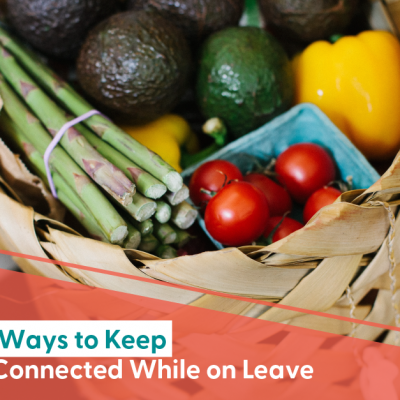What to do? What to do? One of your employees is going on leave and on one hand, you want them to feel they can get all the separation they need during their time off, but on the other, you don’t want them to feel detached, isolated and forgotten about…and then there are the legal ramifications.
Uncertainty around what HR and managers can and can’t communicate to an employee on leave is a major contributor to why keeping in contact can be murky territory. Asking an employee to do anything work-related is a big no-no, but fortunately, we’ve come up with a few ways to creatively keep employees connected on leave while respecting their rights to have time away from work.
- Celebrate important milestones: If an employee is on an extended leave of absence, make sure you recognize their birthday or work anniversaries if they happen to coincide with their time out of the office. It doesn’t even have to be a gift. A simple text or email (ask them their preferred communication method) congratulating them when they’ve reached a life or work milestone can go a long way to making them feel connected while away.
- Invite them to a company event: It’s possible an employee needs to take a leave and will miss a retreat or a company celebration. It’s actually okay to invite them, but it must be made clear that participation is completely voluntary. Some employees just want to feel invited, others might actually want to find a way to attend. If they don’t attend, let them know they were missed.
- Offer resources specific to their leave: Information on grief groups, lactation consultants, and support resources for caregiving are just a few ways you can be helpful from a distance. Offering leave-specific resources remind your employee taking a leave that even if they are away from the office, you care and are there to support them.
- Make communication about their leave easy: Sometimes the best way to keep your employees connected during a leave is to be available to help them throughout their leave journey. When questions arise, and they inevitably will, eschew sending your people to a call center with robo-operators. Instead, provide human support when questions arise and they’ll feel supported and connected.
- Include them in company successes and celebrations: Did your company just have an anniversary? Did you just launch a new product that the employee on leave had a large role in? Excluding them from communications around successes and celebrations while on leave is a good way to make them feel like they are an afterthought. Avoid that by letting them know how much their contributions to the organization are appreciated.
- Send them a gift: A small token of appreciation can go a long way for an employee on leave. Did they just get a new addition to their family? Pick something up off their baby registry if they provided the company one. Are they grieving the loss of a loved one? Send them flowers and include messages of sup]port from their team. You can also let them choose a gift that meets their needs. There are a lot of options out there. We use Goody here at TIlt.
- Have a cardboard cut-out made: (We did say “creative ways” in the headline). It goes without saying that this should be reserved for someone who would appreciate such a gesture, but having a cardboard cut-out made of your colleague on leave is an outside-of-the-box way to keep them feeling connected. Text them updates of their cardboard cutout in meetings or sitting napping in the breakroom or waiting patiently at the printer. It can be a great spirit lift to know that colleagues are thinking about you and miss having you around.
- Organize a Meal Train: Often when taking a leave of absence the activities we take for granted, like being able to procure meals, can be what we need the most. Setting up a program like Meal Train gives your company an easy way to send meals to your colleague on leave.
- Offer to ease the chores burden: For colleagues on leave who have team members nearby, create a sign-up list to help with chores that can help them out in their time of need. Perhaps they were in an accident and are on disability leave. Give their coworkers an opportunity to help mow the lawn, or help with loads of laundry, or shovel sidewalk snow.
- Pet sitting: Find colleagues who will provide temporary pet-sitting services for your people when a leave of absence requires them to leave town can. Any pet parent will know how tricky it is to do any last-minute travel when their fur babies are part of the picture. Curate a list of employees at the ready who will be willing to help pet sit and when the leave request comes in, ask around to see if anyone is available to help out.
- Bring them coffee or bring them breakfast: Delivering meals is a great way to make employees feel connected while on a leave (as we established in #8), but most of the time restaurants only offer these services for lunch and dinner. Having a hot coffee and breakfast dropped off at their doorstep can be such a mood lift and make them still feel like a supported member of your company family.
- Deliver groceries: Whether the employee is suffering from illness or is recovering from childbirth or medical surgery, going grocery shopping can be a massive struggle, if it’s possible for them to do at all. Offer to have some groceries delivered first, don’t do this unannounced, but if they provide a list of items they need it should be easy for an organization to use an app like Instacart, or a generous colleague, to drop off groceries and come through in the clutch.
- Offer to write their thank you notes: Baby shower gifts are wonderful to receive, but thank you notes typically get put on the back burner by new parents who suddenly have much larger priorities in life. A manager can rally the team together for an hour on a Friday and help their colleague knock out that most nagging of to-dos for new parents.
- Check in with them (legally): The tendency to err on the side of caution when it comes to checking in with an employee on leave is a good one in theory from a CYA legal standpoint, but as we’ve established in practice it can make them feel isolated. A “Hi! Just wanted you to know we’re all thinking of you and hope you’re doing well,” text or email or carrier pigeon or whatever their preferred communication method is, is a way to keep your people connected and stay compliant.
- Reminding them that it’s okay to reach out: The truth is not everyone taking a leave wants to be left alone. For some, they might want as little to change as possible in their daily routine regardless of their leave of absence status. Whether that’s the case or not, many employees feel like they can’t or shouldn’t reach out to their colleagues or manager while on leave. Let them know that while as an employer they can’t reach out to the employee about work, the employee on leave should feel like they can touch base if they miss their work life and work friends.
- Establish Employee Resource Groups (ERGs): Medium-to-large-sized organizations can develop ERGs specifically dedicated to provide a safe space for employees to chat with peers while on leave. For example, an employee on maternity or paternity leave can bond with colleagues who have gone, or are going through, similar experiences and can both stay connected and get helpful advice.
Keeping your employees taking leave connected while remaining compliant takes some creativity, but your people will thank you. When in doubt, be open with your communication, if you even think that you might be crossing a boundary err on the side of caution, and make sure you are there for your people in the way they need you to be there.
About Tilt
Tilt is leading the charge in all things leave of absence management through easy-to-use tech and human touch. Since 2017, our proprietary platform and Empathy Warriors have been helping customers make leave not suck by eliminating administrative burdens, keeping companies compliant, and providing a truly positive and supportive leave of absence experience for their people.







